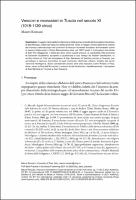Chapter Vescovi e monasteri in Tuscia nel secolo XI (1018-1120 circa)
| dc.contributor.author | Ronzani, Mauro | |
| dc.date.accessioned | 2022-06-01T12:25:34Z | |
| dc.date.available | 2022-06-01T12:25:34Z | |
| dc.date.issued | 2021 | |
| dc.identifier | ONIX_20220601_9788855182959_669 | |
| dc.identifier.uri | https://library.oapen.org/handle/20.500.12657/56484 | |
| dc.description.abstract | The paper deals with foundation and further fortunes of the Florentine abbey of San Miniato, founded by bishop Ildebrando (1018), and discusses the grounds of the strong hostility that Vallombrosan monks demonstrated toward florentine bishops like the same Ildebrando or Pietro Mezzabarba (who 1067 founded the nunnery of San Pier Maggiore). The so-called Vita anonima of John Gualberto, discovered and published by Robert Davidsohn, is particularly hard on these bishops, but it was written around 1120 by a monk of San Salvatore di Settimo (near Florence), in order to discredit the present bishop Goffredo Alberti, brother of count Tancredi Nontigiova. The paper considers also the cases of Pistoia and Pisa, where around the end of 11th century local bishops founded the abbeys of San Michele in Forcole and San Rossore. | |
| dc.language | Italian | |
| dc.relation.ispartofseries | Fragmentaria. Studi di storia culturale e antropologia religiosa | |
| dc.subject.other | Tuscan Episcopate | |
| dc.subject.other | Florentine Episcopate | |
| dc.subject.other | Goffredo Alberti | |
| dc.subject.other | Vallombrosa | |
| dc.subject.other | Pisa | |
| dc.subject.other | Pistoia | |
| dc.title | Chapter Vescovi e monasteri in Tuscia nel secolo XI (1018-1120 circa) | |
| dc.type | chapter | |
| oapen.identifier.doi | 10.36253/978-88-5518-295-9.03 | |
| oapen.relation.isPublishedBy | bf65d21a-78e5-4ba2-983a-dbfa90962870 | |
| oapen.relation.isbn | 9788855182959 | |
| oapen.series.number | 2 | |
| oapen.pages | 32 | |
| oapen.place.publication | Florence |

